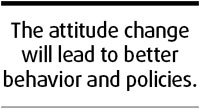Charting the battle against HIV/AIDS
Updated: 2008-01-29 07:30
After following CHARTS - China AIDS Roadmap Tactical Support - projects for more than a year, I have come to appreciate its core idea to link the prevention of this epidemic with efforts to build good governance.

In the three years since the program was launched in January 2005, with joint funding from the Chinese government, UNAIDS and British and Norwegian governments, CHARTS has sponsored a series of projects toward its aim to improve China's strategic capacity to deliver an effective and coordinated response to HIV/AIDS.
Involved in the initiative are not only provinces and autonomous regions where AIDS is spreading at varying rates, but also administrative organs ranging from the ministries of construction, agriculture, education and transportation to the State Administration for Industry and Commerce.
Even the Publicity Department of the Central Committee of the Communist Party of China has joined in efforts to run training workshops for opinion leaders nationwide to correct their, and through them the societal approach to HIV/AIDS.
Behind this extensive government coalition is a change in attitude - from indifference or even discrimination to concern.
As a community official from Gansu in western China put it: "For officials, no matter how low they rank, they should not play safe by keeping themselves clean from the disease while standing aloof from the national battle against AIDS. They are bound to the duty of helping raise AIDS prevention awareness among people around them."
The notion that "every one of us should do something for the control of the epidemic" is a striking contrast to the previous stigma that confines AIDS to certain groups of people and its prevention to health and public security departments only.
The attitude change is bound to lead to better behavior and policies.
In a coalition of 27 government departments in Hubei province, family planners distribute free condoms to sex workers, and tourism administrations urge hotels to place leaflets on HIV prevention, and condoms in guest rooms.
Simple as these actions may appear, they reflect a departure from the past rigidity in cracking down on prostitution, in which condom use could be taken as evidence of criminal offense. Now many police departments have accepted the idea that safe sex does not necessarily mean legalizing prostitution but a practical way of preventing HIV/AIDS.
The practice in Hubei and other places show that while condom use among sex workers has increased, the infection rate of sexually transmitted diseases has dropped, without obvious signs of an increase in prostitution.
The same practical approach is also seen with the use of methadone as a substitute to drug addicts using needles, and peer education is promoted among drug addicts, sex workers and MSM - men having sex with men.
All these groups, vulnerable to HIV infection and subject to discrimination, have remained invisible in the past in Chinese society. As the importance of their participation and cooperation in the battle against AIDS is being recognized, the attitude toward these groups is also changing.
Also under change is the attitude toward the non-governmental organizations (NGO). More and more government officials have come to recognize that NGOs are indispensable in the battle against AIDS and have advantages the government cannot match.
For instance, they have access to some high-risk groups that are beyond the government's reach.
That recognition has resulted in unprecedented cooperation between the government and NGOs. The government not only provides NGOs with funding and training to facilitate their work in the battle against AIDS, but also entrusts some NGOs with drafting legal documents concerning their role in the prevention and control of the disease.
All this has manifested improved governance in the tackling of an epidemic. This is encouraging, and indicates the importance of governance in the successful battle against AIDS.
Of course we cannot attribute all the achievements in the battle against AIDS to a single program like CHARTS. Without the government's willingness to embrace its ideas, without the favorable overall environment created by the Scientific Outlook on Development that emphasizes putting people first and taking people's interests as the starting point, CHARTS could hardly achieve what it has done.
Nevertheless, its concept to link the prevention of a disease to the improvement of governance, and its capacity to put the concept into action, is an inspiration to all of us.
The author is a council member of China Society for Human Rights Studies
(China Daily 01/29/2008 page8)
|
|
|
|
|
|